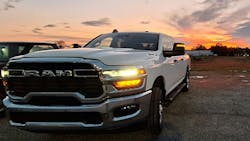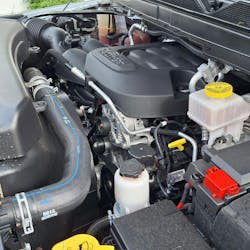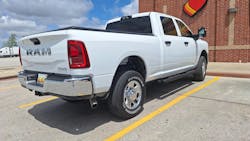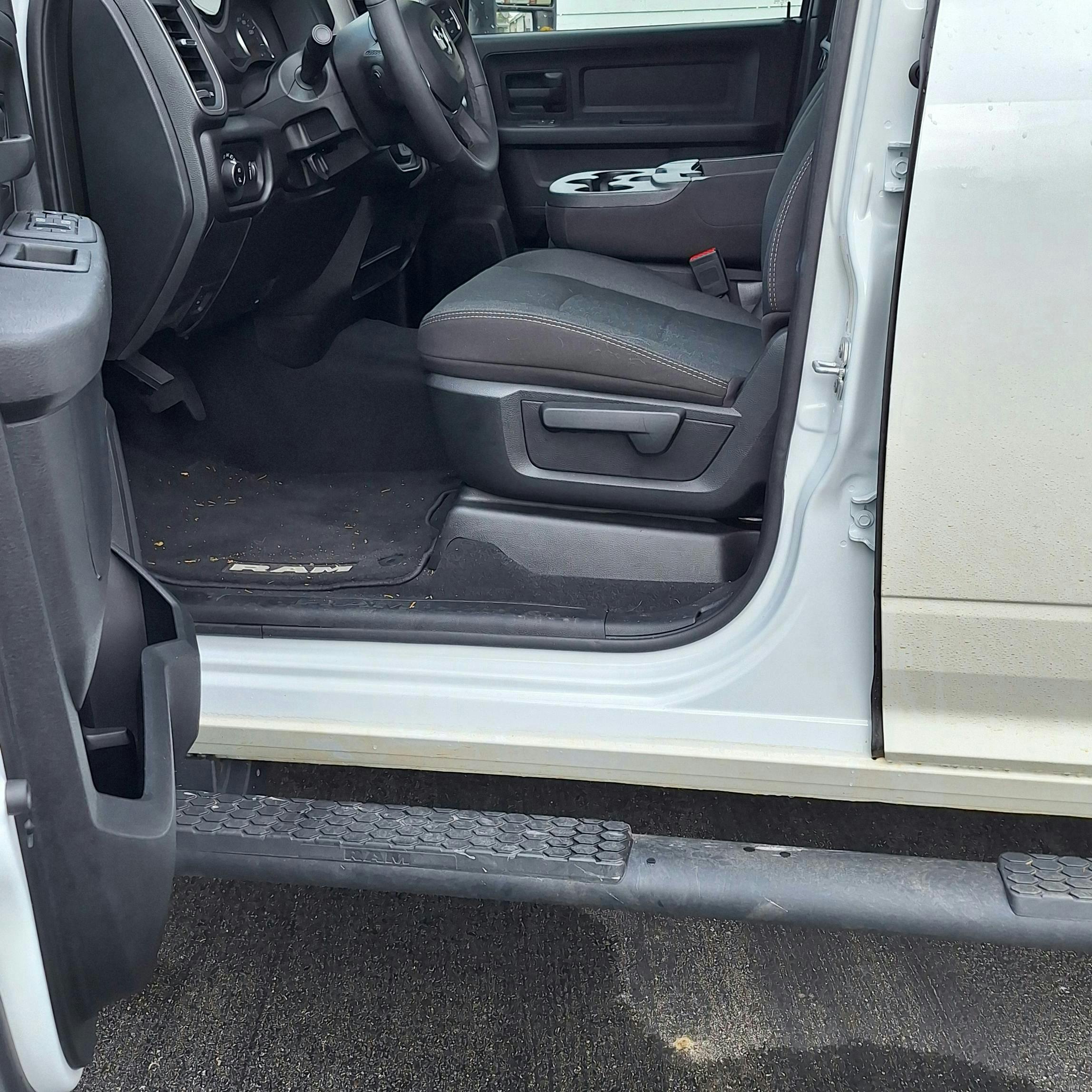There’s a sales segment tracked by truck marketers called “dual use,” meaning vehicles that serve as both work tools and personal transportation. Such owners spend more time in their pickup trucks than construction folks who operate fleet trucks, so driveability, comfort, and infotainment features become as important as the pickup’s ability to haul and tow. I discovered a lot about a 2025 Ram 2500 HD’s personality doing this test, because I drove it from my home near Columbus, Ohio, to Troy, Alabama, and returned a few days later.
There were two 2500 HDs, actually: The first one delivered to my driveway was Cummins Turbo Diesel-powered and blessed with top-of-the-line Limited trim. The second had the 6.4-liter gasoline V8 and was fitted out as a basic Tradesman. Both were big 4x4s with roomy 4-door, 5-passenger crew cabs, like a large majority of all modern pickups are sold today.
Ram 2500HD engines
The 6.7-liter I6 diesel was rated at 430 horsepower and 1,075 lb.-ft., so it really moved the truck. A 98.4-inch bed made for a long wheelbase and overall length: 169 inches and 21.7 feet, respectively. That affected maneuverability, especially in sharp right turns, though a tight wheel cut compensated. On store parking lots, the truck was too long for a single space, so I used two spaces end-to-end.
The second pickup had the lower-cost gasoline V8 with 405 horsepower and 429 lb.-ft. that gave up little in performance. This truck had a relatively short 6-foot, 4-inch bed, cutting overall length by about 2 feet, so it maneuvered better and fit within most parking slots. Both trucks had 8-speed automatic transmissions: a ZF with the Cummins and a proprietary unit with the gasoline V8. Of course, they also had power steering, brakes, etc., and were easy to drive.
I had both trucks for a week each but didn’t drive the Cummins-Limited version much, though I did run around with it enough to appreciate its power and poshness. Leather-covered seats were just the start of its limo-like accommodations. And its “technology” included automatic linking to my cell phone. On one highway drive a female voice suddenly announced that I had a text message and asked if I wanted to hear it. Yes, I answered. She read the message, prompted me to dictate a reply and read that back, then sent it out. Hey, I’m a low-tech guy and this was a breakthrough.
I also noted that the gutsy Cummins diesel was almost too quiet; I seldom heard it and only felt its strength when I punched the accelerator. This high-standing truck had motorized fold-out running boards that, when deployed, sat about midway between the pavement and the cab’s floor, which was about 2 feet up, so I was easily able to climb into and out of it. But I wonder how the mechanisms will stand up to winter road salt and everyday debris.
The gasoline-powered 2500 HD had nerf bars with rubber step areas, but these were mounted higher; I had to grab the handle on the A pillar and the steering wheel’s rim to pull myself in and ease myself out. Of course, I’m a short guy and taller, longer-legged people won’t have much problem with entry and egress. And once in the driver’s seat I was well perched to operate the truck.
This is the 2500 HD that I took to Alabama. Financially it was like getting a free car rental, which I greatly appreciated. The Hemi V8 delivered a pleasurable push when I wanted it and growled authoritatively in the process, and otherwise smoothly loafed along. With 392 cubic inches to feed I didn’t expect high fuel economy and didn’t get it. On one 169-mile stretch in good weather on I-65 in Kentucky, it burned 18.6 gallons of unleaded regular. That’s 16.3 miles per gallon.
More on pickup trucks
- Tariffs bring uncertainty to pickup market.
- Survey offers look at EV transition.
- Chevy Silverado EV drives with power.
I frowned at first, then recalled my old 2003 Dodge Dakota mid-sized pickup with a 4.7-liter V8. I really liked that truck, but it gave me only 17 mpg on the highway. So, 16.3 is pretty good for a heavy full-size truck with its far greater capabilities, and it testified to advances in electronic controls, fuel systems, and combustion efficiency in the past two decades.
Time was limited, so much of my travel was on Interstates—roughly 740 miles down and 780 miles back—and maybe 100 miles locally on two- and four-lane highways and urban streets. It was a good mix of roads and conditions, and it totaled about 30 hours behind the wheel to where I got well acquainted with the husky Ram. Here are some other observations:
Evaluation of the Ram 2500HD
Visibility. A large windshield, side windows, and mirrors provided good visibility all around. Cameras placed around the truck’s perimeter showed things not directly seen. The high nose obscured stuff close in front, but I could observe that area, as well as alongside and to the rear, on the large, color display screen.
Ride quality. The suspensions were stiff to support the designed-for payload of 4,420 pounds (1,680 more than with the heavier diesel, by the way). I expected a choppy ride and got one, but it was not as much as I expected. A look into a wheel well showed why: The rear springs were coils, not leafs, so were inherently softer riding. Soon I got accustomed to the firmer ride except for a long, really rough stretch of I-59 in northeast Alabama that shook things up. Here the tougher suspension was an effective defense against damage to the truck.
Steering feel. Steering was firm but easily manageable, even while bending tight corners. And the turning circle was smaller than I expected, which was a help in several situations. One was on a dark and rainy night when Google Maps in my phone stopped giving audible directions and I got lost while looking for a relative’s house and had to turn around several times.
Seat comfort. Comfort was excellent, with supportive contouring of the base and back and well-shaped bolstering in the driver’s seat, which is the only one I sat in. Being a base-level Tradesman, the seat had manual adjustments, which were entirely adequate. The gray cloth coverings had a rugged look and feel and breathed better than leather.
Lighting. At night I appreciated strong head- and fog lamps, and nicely illuminated virtual gauges and graphics in the dashboard. Many switches and controls, though, were on the big display screen. For instance, the HVAC controls appeared after hitting a “comfort” button. Curiously, they cannot be used at highway speeds: “Feature not available while underway,” a message said. Redundant HVAC buttons are at each side of the screen, however, and those work at any speed.
Radio controls likewise appeared on the screen after I pressed “audio,” but these also disappeared when I tried to change a station or Sirius XM channel. I was stuck with what I had chosen until I slowed down or stopped. I’m not an audiophile, but sound quality through a multi-speaker system was good.
Driver-assist features. I give these features mixed reviews. The adaptive cruise control adjusted speed to match traffic ahead in the same lane, but too often I found that the truck had slowed to 60 or so mph because that’s what the car ahead was doing. Swinging out to pass let the CC resume the higher speed I wanted. One solution was adjusting the following distance that CC observed: Cut the distance from 4 seconds to 2 and the slow-down comes later and a bit more forcefully, which serves as an alert. This I did with one of the many switches on the steering wheel’s spokes.
Automatic braking engaged if I came up on traffic too fast. Once I let the truck pull up to a car at a stop sign and my truck slowed and stopped, then took off again when that car moved out of the way. Neat.
Not so neat was automatic changing of the headlamps’ high and low beams. Out on dark country highways this worked well, but on suburban roads the system mistook distant streetlights for oncoming vehicles and locked out the high beams. I suspected there was a safety obsessed nanny stowed away inside the dashboard and wished I could fire her. But I’d keep the truck.
About the Author
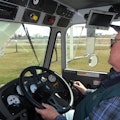
Tom Berg
Tom Berg is widely acknowleged as one of the top truck writers in the industry. He has covered construction for more than 34 years, and has test-driven well over 150 trucks for Construction Equipment.
